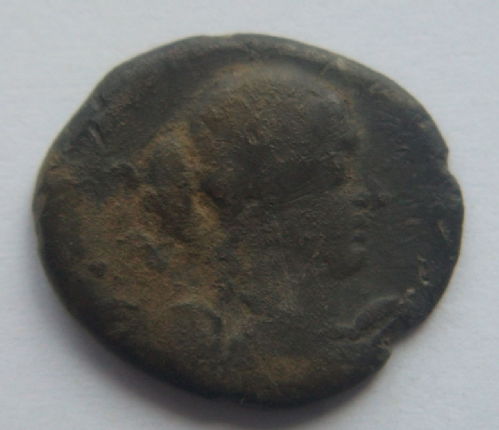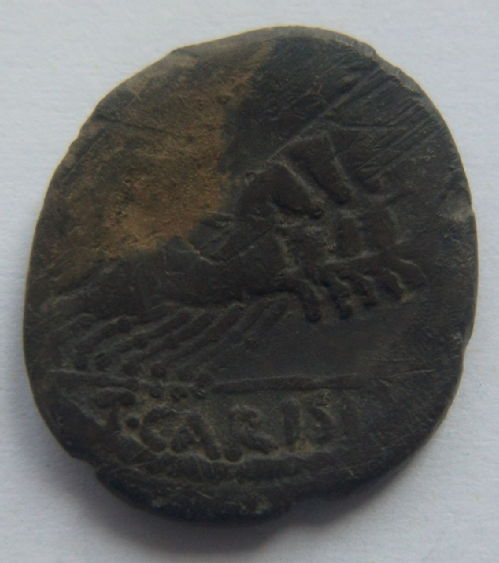In the shadow of a dictator
 |
 |
Coin of Titus Carisius
Obverse: Victoria right, SC behind. Reverse: Victory driving a Quadriga, T.CARISI in exergue (Sydenham 985, Crawford 464/5)
If one were to poll 100 individuals about the name ‘Titus Carisius’, all 100 would be forgiven for having never heard of him. His appearance in the Roman Republican monetary record is simply overshadowed by the folklore popularity of contemporary figures such as Pompey the Great and Julius Caesar. Even Roman historians only briefly record the exploits of the gens Carisia, the lineage from which Titus descends. Cassius Dio refers to a ‘Titus Carisius’, presumably the same individual as our moneyer, defeating the native Astures in the province of Hispania and founding a colonia there (Dio LIII.25.8). However, the later historian Florus records the same feat of 25BC as the exploits of a legate with the praenomen ‘Publius’ not ‘Titus’ (Epitome II.33; Florus lived from c. 70 – 140 AD). It would appear from the subsequent coinage of the new colonia founded for the Legio V Alaudae and Legio X Gemina that Florus was correct in his documentation as coin legends clearly record P. CARISI as the legate and pro-praetor. Such confusion therefore compounds the disappearance of Titus Carisius from history. This article seeks to re-establish this forgotten triumvir monetalis of 46 BC alongside the recognizable names of the period, by evaluating one example from the fascinating series of coins he produced.
The actual coin used in this article is a recent discovery from Britain that has inspired this piece. At first glance it would appear to most as an ordinary example of Republican coinage, displaying the personification of a goddess on the obverse with a symbol of Republican Rome on the reverse. In this case it depicts a quadriga (4-horse chariot); a symbol used on the earliest denarii of 211 BC. This traditional symbol twinned with a goddess here would not look out of place amongst those late 3rd century BC issues, were it not for the goddess depicted on our coin. The personification of Victoria with the legend S.C adorns the coin’s obverse, a symbolization therefore of a victory commemoration.
History does not record a triumph of the gens Carisia in 46 BC when this coin was struck, nor is there a documented history of the Carisian line before the mid 1st century BC. So it is unlikely this coin issue commemorates a family victory. It must therefore herald the victory of a contemporary event or figure - Julius Caesar. Such a conclusion should not be remarkable, considering Caesar had just been declared a dictator for ten years. He was therefore well-known, holding a position of direct and indirect influence over the coinage minted. Another known type of Titus Carisius depicts a cornucopia above a globe with a sceptre and rudder on either side (Crawford 464/3A). Such imagery evokes ideas of wealth and prosperity over the globe, with the rudder acting as a guide. This is comparable with Caesar’s accomplishments in annexing Gaul and forays to Britain in the previous decade.
Furthermore, connections between the quadriga-issue and a Caesarian triumph can be identified when Caesar’s own coin types are considered. It is widely accepted that Caesar continued his own coin production from his moving Spanish mint in 46 BC, striking types that reference his victory in the bello gallico of 58-50 BC (See RSC 13; Sydenham 1014; Crawford 468/1). Further links between the two can be found from an inscription (Figure 1) discovered in Avignon in 1841 believed to date from the third quarter of the 1st century BC (see Christol, M: Une nouvelle dédicace de T(itus) Carisius, praetor Volcarum, près d'Ugernum (Beaucaire, Gard) 2005 for more information). It briefly records a “Titus Carisius, son of Titus, Praetor of the Volcarum”, leading to speculation that Titus may have been the son of a soldier of the Volques tribe of Southern Gaul, granted Roman citizenship during Caesar’s time. This offers a potential explanation for a lack of records for a gens Carisia prior to the 1st century BC and even circumstantial evidence of historical connections between a character likely to be our moneyer and Caesar. Therefore it is by no means a stretch of the imagination to compare their coinages.

Figure 1: Avignon Inscription (Wikimedia Commons)
The reverse of our coin has similar Republican-themed imagery, with an unmistakable figure driving a quadriga with T.CARISI beneath in the exergue. Once more the personification of Victory appears, again suggesting that this coin’s message of victory is too forceful to be unintentional – hinting at the fusion of existing Republican iconography with contemporary Caesarian ideology. On reflection, this may provide the ultimate reason why ‘Titus Carisius’ has been virtually erased from history. The fact this coin type is so similar to many other Republican issues, as well as being loaded with Caesarian propaganda, aided Carisius’ disappearance. However one factor remains that explains how I am able to write such an article upon Carisius’ coinage - his name. The very fact that Titus Carisius ascribed his own coinage, a standard practice among Republican moneyers, gives us a small window into the dying days of the Republic, a time clearly dominated by the actions of one man and his heirs. Yet this coin offers more; it provides insight into the actions and presumably the aspirations of other forgotten members of the ruling classes. Does this coin, however subtly clouded in Caesarian propaganda, radiate a hope for the restoration of earlier Republican values by utilizing an established coin design, or does it simply confirm the acceptance of a dictator? However likely the latter is from the available evidence, the true meanings of the coin have unfortunately been lost to the passage of time. I am however certain of one thing… I’m glad he left us his name.
 Written by Gregory Edmund, currently a 2nd Year Undergraduate studying Ancient History at the University of Warwick. His main interests lie in Republican Roman coinage (after 211BC) as well as Iron-Age and Roman Britain.
Written by Gregory Edmund, currently a 2nd Year Undergraduate studying Ancient History at the University of Warwick. His main interests lie in Republican Roman coinage (after 211BC) as well as Iron-Age and Roman Britain.
 Clare Rowan
Clare Rowan


 Loading…
Loading…
Anna
Hello! Is there any information what material is the coin of Titus Carisius made from?
Thank you in advance for the answer!
Anna
05 Jul 2018, 06:22
Clare Rowan
Hi Anna
These particular coins are made of silver (hard to tell from the specimen we included in the photo here I know!) More information is available at:
http://numismatics.org/crro/id/rrc-464.5
09 Jul 2018, 11:16
Add a comment
You are not allowed to comment on this entry as it has restricted commenting permissions.